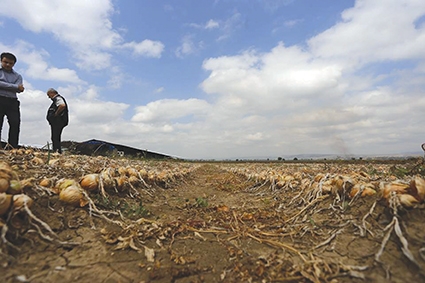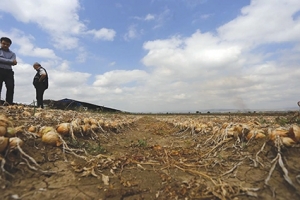Georgia’s Quest to Promote Agricultural Insurance
Agriculture is Georgia’s lifeblood. Fifty-three percent of the country’s working population is engaged in agriculture, many working on small plots of one hectare or less. The family farm is the backbone of Georgia’s rich rural culture. But from a financial perspective, it’s far from a sure thing. The agriculture sector employs more than half of Georgia’s workforce but accounts for only 10 percent of GDP. Many farmers earn little or no cash income. When natural disaster strikes and crops fail, rural families have little to fall back on.
The fragility of that life became obvious in August 2015, when a storm destroyed roughly 2,300 hectares of land in Kakheti. Hail, rain, and wind whipped across the landscape for 25 minutes. During that time, numerous homes and large numbers of livestock and crops were destroyed. In the Akhmeta region, the entire grape harvest was destroyed by a mudslide brought on by the storm.
Crop damage is difficult to avoid when harsh weather hits. Limiting the financial fallout can be an effective strategy, however. “Insurance is very important for financial security”, said Tamar Toria, Executive Director of the Georgian Farmers Association, in an interview with GEORGIA TODAY. That’s why, in 2014, the government introduced a program to expand enrollment in agricultural insurance schemes. Widely used in the European Union, crop insurance is still a novel concept in Georgia. Many farmers don’t know about the available options. In fact, Toria cited the lack of information as the strongest factor holding back insurance.
Rather than buy insurance policies, farmers traditionally rely on the government to compensate their losses. For example, after a major 2012 storm, affected farmers received a total of GEL 150 million from the government and GEL 150 million from a private fund. But according to Toria, a government bailout is never certain. “It’s the government’s free will to assist. No compensation is guaranteed.”
The government is working to build a positive culture around agricultural insurance. In September 2014, the Agricultural Projects Management Agency (APMA) rolled out the Agro Insurance Program. By combining financial subsidies with a program to raise awareness, APMA hopes to increase the prevalence of insurance, which should reduce both overall risk and dependence on government bailouts.
Farmers are able to purchase insurance against hail, excess rainfall, storms, and autumn frost. The insurance is provided by private companies in partnership with APMA. In 2014, the government covered 94 percent of the tab on every insurance policy sold; farmers were liable for the rest. The program sold 20,952 policies and saw 18,596 hectares of land insured during the first year. However, its very success highlighted a serious problem. Farmers bought insurance largely because it was heavily subsidized.
The next year, APMA made the program less generous. The government covered only 40-60 percent of the cost (the higher rate excluded grape production), and subsidies were available only to farms of five hectares or less. Only 3,439 new policies were sold through the first eight months of 2015. Only 3,112 hectares were insured (to be fair, the drop was due in part to farmers purchasing coverage for 2015 during the previous year). Once farmers had to assume the financial risk themselves, insurance looked less attractive. Additionally, many farmers reported being unhappy with the loss adjustment process. Things went back largely to the way they were.
APMA recognized the problems with the Agro Insurance Program and is addressing them with help from foreign development organizations. For example, the Swiss Agency for Development and Cooperation (SDC) is playing a role through its project, “Promoting Access to Finance and Agri-Insurance in Georgia” (PAFAI). PAFAI’s work includes advising the government on agro-insurance regulation and public-private partnerships, as well as promoting insurance literacy on the part of farmers. It’s doing the latter by creating and distributing educational materials, including easy-to-understand brochures and videos.
The government is also working with its partners to improve the loss adjustment process: “We are working hard with SDC’s project PAFAI and with insurance companies on [improving] loss adjustment”, said Levan Maghradze, a project manager with APMA, during an interview with GEORGIA TODAY. “We are highly motivated to create a clear and transparent loss adjustment methodology as we think it is crucial for insurance schemes and for long-term and sustainable development.” In addition, APMA has increased subsidies by 10 percent from their 2015 levels and introduced incentives for farmers to register their lands.
By improving the quality of the product and increasing awareness about it, the government hopes that more farmers will buy insurance, even if the subsidy is less generous than it was in 2014. The Georgian government, its foreign and private-sector partners, and farmers themselves face a long road toward expanded use of agriculture insurance. But if the Agro Insurance Program and other initiatives can be effectively put in place, Georgian farmers will be in a stronger, more secure position.
Joseph Larsen











